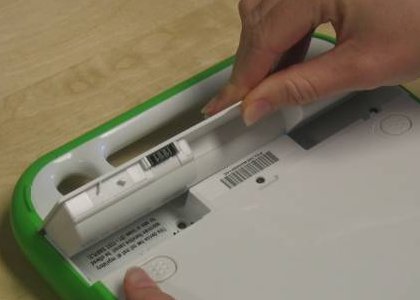Battery Charging: Difference between revisions
m (categorization & cosmetics) |
|||
| Line 3: | Line 3: | ||
=Battery Charging= |
=Battery Charging= |
||
==Types of Batteries== |
==Types of Batteries== |
||
OLPC is using two battery chemistries: NiMH, and LiFePo batteries. The LiFePo batteries allow charging at higher temperatures. The NiMH batteries cannot be charged above about 45 degrees C. |
OLPC is using two battery chemistries: NiMH, and LiFePo batteries. The LiFePo batteries allow charging at higher temperatures. The NiMH batteries cannot be charged above about 45 degrees C. |
||
==Recovery of Dead Batteries== |
==Recovery of Dead Batteries== |
||
===BTest-1 Systems=== |
===BTest-1 Systems=== |
||
===BTest-2 Systems=== |
===BTest-2 Systems=== |
||
==Long Term Storage== |
==Long Term Storage== |
||
[[Image:Battery-2.jpg|right]] |
|||
If you plan to store a system for many weeks or months, your best strategy is to fully charge the battery and <b>remove</b> the battery from the laptop. Batteries naturally lose charge with time (how fast depends on the battery and its chemistry), and the embedded controller in the laptop, while sipping tiny amounts of power in its low power state, will drain the battery faster. Batteries are also known to leak. |
If you plan to store a system for many weeks or months, your best strategy is to fully charge the battery and <b>remove</b> the battery from the laptop. Batteries naturally lose charge with time (how fast depends on the battery and its chemistry), and the embedded controller in the laptop, while sipping tiny amounts of power in its low power state, will drain the battery faster. Batteries are also known to leak. |
||
| Line 14: | Line 22: | ||
As you can see above, letting a battery drain all the way will cause problems when recharging, how severe depends on the circumstances. |
As you can see above, letting a battery drain all the way will cause problems when recharging, how severe depends on the circumstances. |
||
[[Category:Hardware]] |
|||
Revision as of 15:56, 30 March 2007
Battery Charging
Types of Batteries
OLPC is using two battery chemistries: NiMH, and LiFePo batteries. The LiFePo batteries allow charging at higher temperatures. The NiMH batteries cannot be charged above about 45 degrees C.
Recovery of Dead Batteries
BTest-1 Systems
BTest-2 Systems
Long Term Storage
If you plan to store a system for many weeks or months, your best strategy is to fully charge the battery and remove the battery from the laptop. Batteries naturally lose charge with time (how fast depends on the battery and its chemistry), and the embedded controller in the laptop, while sipping tiny amounts of power in its low power state, will drain the battery faster. Batteries are also known to leak.
This strategy is true for all battery powered equipment.
As you can see above, letting a battery drain all the way will cause problems when recharging, how severe depends on the circumstances.
